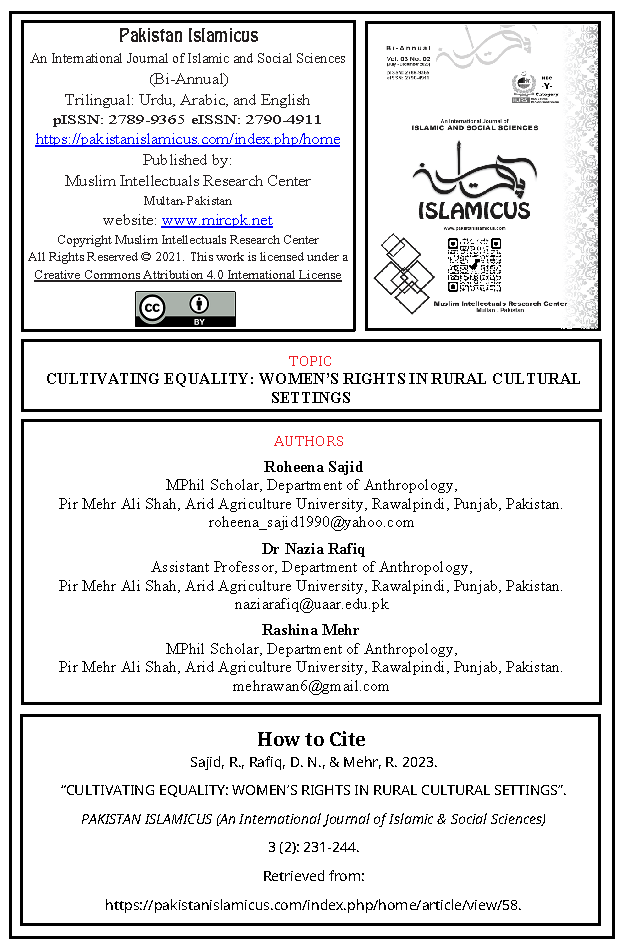CULTIVATING EQUALITY: WOMEN’S RIGHTS IN RURAL CULTURAL SETTINGS
Keywords:
Women's Rights, Culture, Gender, Agency, Sustainable Development, Women’s Empowerment, Women’s EducationAbstract
This study is about women's rights and the way these rights are influenced by cultural settings. To study the relationship between women's rights and culture, an anthropological lens will be used to understand the phenomenon. This is an exploration of the idea, of up to what extent; culture is responsible for influencing women's rights in different cultures and how the cultural settings can be transformed to encourage and ensure gender equality.
The relevant literature suggests that there is a close relationship between women's rights and the culture, they live in. Multiple studies have proved that there is a strong correlation between the culture and the provision of women's rights. This study will focus on the issues of women's rights and will explore their link to the cultural settings.
It is predominantly, a qualitative study that will employ the inductive research approach. Participants of the study include men and women from rural areas. Two different cultures within a rural setting have been selected for the study. This is because; it will bring clarity about women's rights and their relationship with the relevant cultural settings. Different data collection techniques will be used including in-depth interviews, archival research, and secondary data collection (data sets that have already been collected by government agencies or research organizations).
This topic is interesting and worth researching because there is no substantial research available on the relationship between women's rights and culture in Pakistan. Pakistan could not achieve its goals that were committed in the CEDAW (Convention on Elimination of all Forms of Discrimination against Women) and Sustainable Development Goals (2030) declarations. So, this study has both practical and theoretical importance. Furthermore, this study will also give a way out and coping strategies for including women in the process of development and to ensure gender equality. Moreover, this study may encourage policy-makers to focus on the solution of the phenomenon.
References
Ali, P. A. (2008). Violence against women in Pakistan: A framework for analysis. Pakistan Medical Association, 58(4), 198.
Ali, T. S. (2007). Strategies and recommendations for prevention and control of domestic violence against women in Pakistan. Journal of Pakistan Medical Association, 57(1), 27.
Chaudhry, I. S. (2007). Gender inequality in education and economic growth: case study of Pakistan. Pakistan Horizon, 60(4), 81-91.
Deborah L. Best, A. R. (2019, July).
https://academic.oup.com/book/34980/chapterabstract/298640932?redirectedFrom=fulltext. Retrieved 09 13, 2022, from https://academic.oup.com/.
Dewey. (n.d.). https://psycnet.apa.org/record/2006-03523-007. Retrieved from
Donnelly. (2006). https://www.researchgate.net/profile/William
Trochim/publication/243783609_The_Research_Methods_Knowledge_Base/links/55db837008aed6a199ac6246/The-Research-Methods-Knowledge-Base.pdf. Retrieved from
Flick, U. (2009). https://www.ssoar.info/ssoar/handle/document/33655. Retrieved from https://www.ssoar.info.
Khan, N. H. (2020). Analysis of women March day in the world and its impact on women culture in Pakistan.
Khurshid, A. (2016). Domesticated gender (in) equality: Women’s education & gender relations among rural communities in Pakistan. International Journal of Educational Development, 51, 43-50.
Moghadam, V. M. (March, 1992). PATRIARCHY AND THE POLITICS OF GENDER IN MODERNISING SOCIETIES: IRAN, PAKISTAN AND AFGHANISTAN.
Noureen, G. &. (2011). Women’s education in Pakistan: hidden fences on open frontiers. Asian Social Science, 7(2), 79-87. (2000). Organisation for Economic Co-operation and Development.
Ortner, S. B. (1974). Woman Culture and Society. Stanford University Press, California.Sahih/Authentic (Muslim). (n.d.).
Sandhu, A. M. (2012). Politics of Women’s Education in Pakistan: An Analysis of Government Policies and their Implementation. Pakistan Journal of History and Culture, 33.
Sudduth, J. T. (2009). CEDAW's Flaws: A Critical Analysis of Why CEDAW is Failing to Protect a Woman's Right to Education in Pakistan. 38, 563. (2016).
The Global Gender Gap Report. World Economic Forum. (2016).
The Global Gender Gap Report. Retrieved from https://www3.weforum.org/.UN Women. (n.d.). https://data.unwomen.org/country/pakistan. Retrieved from https://data.unwomen.org.
United Nations Women. (n.d.). https://data.unwomen.org/country/pakistan. Retrieved from https://data.unwomen.org.
United Nations Women. (2017). https://asiapacific.unwomen.org/en/search-results?search_api_fulltext=2017%20reports&f%5B0%5D=country_search%3A1659.
United Nations Women. (2021). Violence Against Women During Covid-19.
United Nations Women. (February 2021). https://asiapacific.unwomen.org/en/digital-library/publications.

Downloads
Published
Issue
Section
License
Copyright (c) 2023 PAKISTAN ISLAMICUS (An International Journal of Islamic & Social Sciences)

This work is licensed under a Creative Commons Attribution 4.0 International License.
This work is licensed under a Creative Commons Attribution 4.0 International License.

































